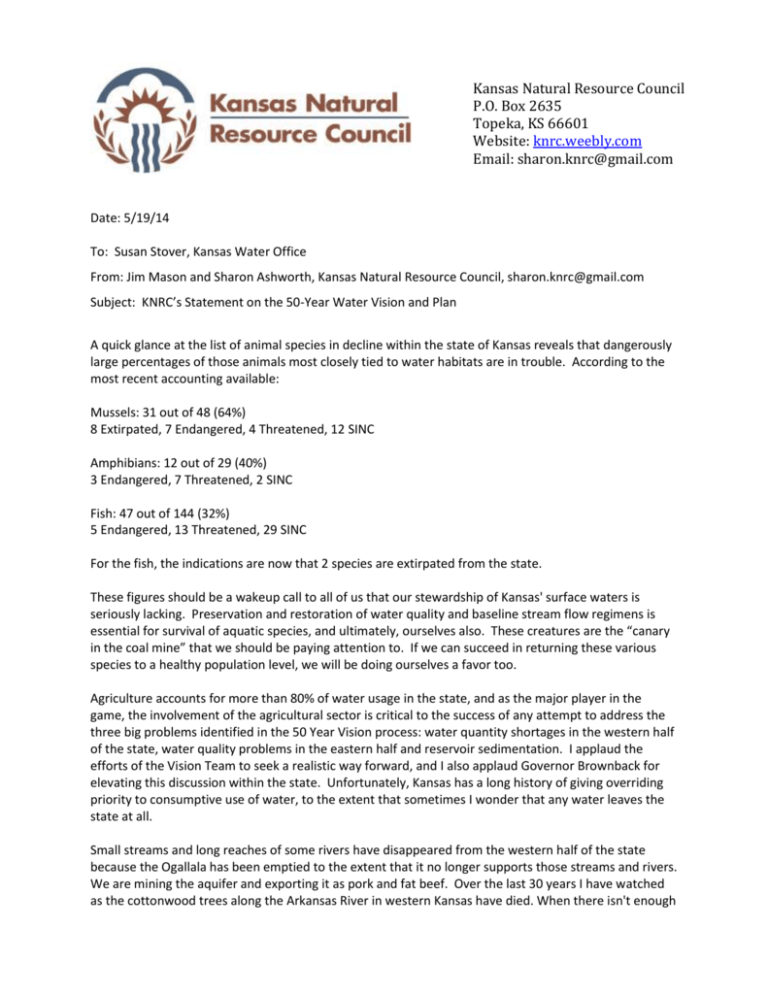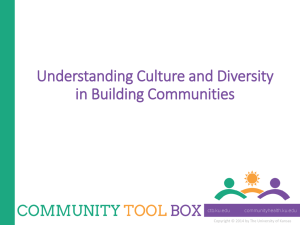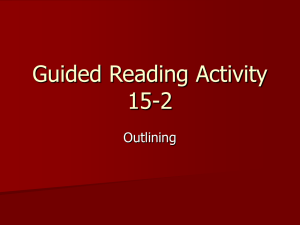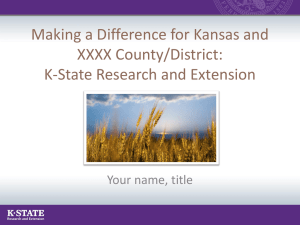File
advertisement

Kansas Natural Resource Council P.O. Box 2635 Topeka, KS 66601 Website: knrc.weebly.com Email: sharon.knrc@gmail.com Date: 5/19/14 To: Susan Stover, Kansas Water Office From: Jim Mason and Sharon Ashworth, Kansas Natural Resource Council, sharon.knrc@gmail.com Subject: KNRC’s Statement on the 50-Year Water Vision and Plan A quick glance at the list of animal species in decline within the state of Kansas reveals that dangerously large percentages of those animals most closely tied to water habitats are in trouble. According to the most recent accounting available: Mussels: 31 out of 48 (64%) 8 Extirpated, 7 Endangered, 4 Threatened, 12 SINC Amphibians: 12 out of 29 (40%) 3 Endangered, 7 Threatened, 2 SINC Fish: 47 out of 144 (32%) 5 Endangered, 13 Threatened, 29 SINC For the fish, the indications are now that 2 species are extirpated from the state. These figures should be a wakeup call to all of us that our stewardship of Kansas' surface waters is seriously lacking. Preservation and restoration of water quality and baseline stream flow regimens is essential for survival of aquatic species, and ultimately, ourselves also. These creatures are the “canary in the coal mine” that we should be paying attention to. If we can succeed in returning these various species to a healthy population level, we will be doing ourselves a favor too. Agriculture accounts for more than 80% of water usage in the state, and as the major player in the game, the involvement of the agricultural sector is critical to the success of any attempt to address the three big problems identified in the 50 Year Vision process: water quantity shortages in the western half of the state, water quality problems in the eastern half and reservoir sedimentation. I applaud the efforts of the Vision Team to seek a realistic way forward, and I also applaud Governor Brownback for elevating this discussion within the state. Unfortunately, Kansas has a long history of giving overriding priority to consumptive use of water, to the extent that sometimes I wonder that any water leaves the state at all. Small streams and long reaches of some rivers have disappeared from the western half of the state because the Ogallala has been emptied to the extent that it no longer supports those streams and rivers. We are mining the aquifer and exporting it as pork and fat beef. Over the last 30 years I have watched as the cottonwood trees along the Arkansas River in western Kansas have died. When there isn't enough ground moisture to keep a riverbank cottonwood going, you know things are getting serious. And this is not just a matter of keeping trees and minnows and frogs alive. Many farmers who were not fortunate enough to be situated over the "fat" part of the aquifer have already given up irrigation because either their part of the aquifer is just plain gone, or they can no longer pump the water at a reasonable cost. There is no equally profitable agricultural paradigm they can transition to. Will the rest of the irrigators just keep drawing the aquifer down until every producer is out of business? Where do the municipalities get their water at that point? You cannot have cities without a water supply for the people living in them. Every year that this situation goes on unchanged, we get closer and closer to creating the Buffalo Commons. And no nefarious government body is responsible; we are doing this to ourselves. Regarding water quality, I believe the Clean Water Act set a very reasonable, commonsense standard: Surface waters should be fishable and swimmable. You should be able to go fishing at a stream, river or lake and find a diverse and healthy population of fish that are safe to eat. And you should be able to jump into the local swimming hole and not worry about being exposed to toxic chemicals or catching a debilitating disease. I think those are goals every Kansan would see as desirable. I hope we can all agree to make them attainable as well. We have come a long ways from the bad old days of the 1970s when the CWA was passed. Point sources of pollution have largely been taken care of. What remains is to address non-point sources, and, again, agriculture must be involved to reach those goals. It is to every producer's advantage to fully implement Best Management Practices on their land. Every ton of topsoil that washes off a crop field is a blow to the farmer's main capital resource. And every pound of fertilizer or chemical that does not stay where it was applied is a waste of the farmer's money, reducing the profitability of their operation. It only makes sense to keep the soil, fertilizer and chemicals in place and not let them get away. Reservoirs will inevitably silt in over time. Each river, particularly in a state like ours, will carry suspended material in the water column and when that water slows down, in an impoundment for instance, that material will fall out. However, there is a reason why El Dorado Lake is in much better shape in that regard than so many of our other lakes, namely most of its watershed is in the Flint Hills and the topsoil is anchored by a continuous cover of prairie grasses and forbs. This is instructive for how we can make progress and reduce the sedimentation going forward. We must do all we can to keep topsoil on the land and not allow it to be stolen from farmers by erosion. I know there are numerous cost share programs and advisory capabilities among the different state and federal agencies to help producers get this done, and I hope more can be done to augment these programs and increase participation in them by producers. I hope I have demonstrated that when I speak out for protection of aquatic species of wildlife, I am not ignoring the Kansas economy or the future of the people who live here and their descendants. It’s all part of one piece. Critters need water, and people are critters too. I hope the 50 Year Vision that comes out of the current planning effort recognizes the importance of water to maintain all the living creatures that inhabit this state. It’s a matter of enlightened self-interest to do so. - Jim Mason, KNRC Board Member VISION and MISSION STATEMENT FOR THE FUTURE OF WATER IN KANSAS WORKSHEET Vision Big Picture Idea of What You Want to Achieve KWO DRAFT: Kansans are committed to having the water resources necessary to support the state’s social and economic needs and to provide for long-term opportunities and statewide economic growth. Thoughts and feedback regarding this draft vision statement: KNRC’s recommendation: Kansans are committed to having the water resources necessary to support our social and economic needs, while protecting water resources and water quality for wildlife and for future generations of Kansans. MISSION General Statement of how you will achieve your vision KWO DRAFT: Develop framework, policy and tools, in concert with stakeholders, to manage the state’s water resources that balance conservation with economic growth, as well as secure, protect and restore water storage and supply. Thoughts and feedback regarding this draft vision statement: KNRC’s recommendation: Develop a framework, policies and tools, in concert with the Kansas public, to manage the state’s water resources such that water use is balanced with protection and conservation to restore and sustain water quality, storage, and supply. GOALS General Statements of what you want to achieve, integrated with vision and mission Ideas and comments: 1) Induce greater efforts in municipal water conservation 2) Reduce the rate of reservoir sedimentation 3) Maintain minimum viable stream flow in designated streams and rivers throughout Kansas 4) Improve water quality in streams and reservoirs 5) Adopt appropriate technologies, regulations and management for inorganic substances, including salts that contaminate water used for oil and gas mining. 6) Protect the remaining wetlands critical to the central flyway 7) Induce sustainable use of the Ogallala aquifer 8) Expand efforts to educate all Kansans about water use, protection, and conservation 9) Fully fund the State Water Plan STRATEGIES Series of actions or activities designed to achieve the goals Ideas and comments: 1) a. Develop and adopt grey water policies and infrastructure. b. Implement conservation minded pricing structure for water rates. c. Expand water conservation and protection education as a state priority. Water conservation and protection education strategies should be tailored to localities within the larger framework of a state priority. 2) a. Fund and implement best management practices for sediment control and streambank stabilization for all our reservoir watersheds. b. Consider where interbasin transfer of water might stabilize a critical reservoir shortage but not threaten the water supply and quality of the donor reservoir. 3) Include and enforce minimum viable streamflows when establishing water management goals for groundwater management districts and for reservoir management. 4) a. Implement best management practices for sediment control in urban areas as well as agricultural areas. b. Increase funding for wetland restoration and buffer areas adjacent to waterways and reservoirs. c. Control the runoff of nitrogen and phosphorus into our reservoirs and rivers that leads to poor water quality conditions and can create conditions for toxic algae blooms. Sediment control and wetland restoration can curtail nutrient runoff and these practices should be encouraged through educational and financial means. 5) Adopt appropriate technologies, regulations and management for inorganic substances, including salts that contaminate water used for oil and gas mining. 6) Regularly update and fund management plans for Cheyenne Bottoms, Quivira, Jamestown, Slate Creek, and McPherson wetlands, taking care to ensure critical wetland functions. 7) a. Improve monitoring and enforcement of allowable pumping rates. b. Compare models of groundwater management (LEMAs and IGUCAs) and apply region specific best practices. c. Reexamine and reimagine state water law to reduce incentives for overpumping, increase incentives for sustainable use, and promote flexibility in water use. One such change might be to examine the possibility of putting a price on water. d. Support cultivation of alternative crops and alternative grazing practices that use less water. e. Support the production of grass-fed beef as an alternative to grain fed beef. 8) Expand water conservation and protection education as a state priority. Water conservation and protection education strategies should be tailored to localities within the larger framework of a state priority. 9) Reestablishing priorities, adopting best practices, supporting surface and groundwater quantity and quality protection strategies, and educating all Kansans about present and future water needs will require money. Fully funding the State Water Plan would be an initial signal that the State of Kansas is ready to tackle the issue of water in Kansas now rather than continue to burden future generations with critical decisions and critical consequences. Respectfully submitted, Kansas Natural Resource Council








